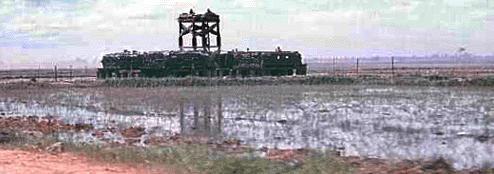War wouldn't be war without lots of things that go bang, now would it?
That's why we liked C-4. It was easy to use, and it made noise. Lots of
noise. C-4 is a plastic explosive. The pale white foot-long bars come wrapped
in olive-drab cellophane. Each is two inches across and one thick. It's just
like a long bar of soft clay, easy to knead with your fingers. Even though it is a
high explosive, most of the time it is absolutely harmless. In a pinch we used it to
heat "C" rations. Just tear off an inch-square cube, put it on the ground
and light it. It burned hot and gave off a chemical smell, but it heated the food
quickly. The only rule was to let the stuff burn out completely, and never, never
try to stamp it out!
C-4 was versatile. We often used it to clear booby-traps. One bar of C-4, a
blasting cap, and a length of fuse would destroy anything Charlie could put together.
When we'd find small caches of ammo or mortar rounds, we'd set them off with C-4.
At Patton it came in handy in several situations. One man was swinging a heavy
sledge hammer when the handle broke off right at the head. We had no tools to
extract the remaining piece of wood, so chances of repairing it seemed remote. After
trying everything else, we decided to use C-4. We stuck a small wad of explosive
onto the wood, pushed a blasting cap into it, and set it down with the explosive
underneath. We lit the fuse and stepped back a very respectful distance. The
flame flickered quickly down the length of the fuse.
Wham! The blast threw the head ten feet into the air in a cloud of
dust. We went over to inspect the damage. The heavy metal sledge head showed
no effects of the explosion, but the wooden plug was gone, disintegrated by the force of
the blast. We inserted a new handle and went back to work.

Another time, a culvert down the road from the base clogged, and again we found
ourselves without the tools we needed. But we did have our trusty C-4 and out it
came. We selected a whole bar, inserted the cap, and attached a very long fuse.
We placed the explosive deep within the tangle of brush blocking the metal culvert.
We were still debating whether the water rushing by the culvert would kill the fuse
or soak the plastic, when a geyser rose into the air, and a satisfying explosion filled
our ears. Moments later water came rushing through the pipe and the flood waters
washing out the road receded.
How powerful was C-4? Well, from our point of view, it was powerful enough.
Once we rolled a full bar into a pencil-thin string and girdled a tree with it.
We set it off and watched. The C-4 cut through the foot-thick trunk with
ease.
Sometimes we got a little too ambitious with the possibilities of C-4. C-4 also
came packaged in a braided rope. We speculated that by tying a weight to one end of
a C-4 rope, we could toss it into a hedgerow ahead of us. The explosion would
detonate any booby-traps hidden in the brush, saving us the danger of just walking through
and finding them. We had only to wait a day or two for a chance to try it out.
We had moved into a gravel-carpeted clearing, with occasional clumps of dried grass,
and low bushes scattered here and there. A thick hedgerow lay directly in our path.
The line halted, and we waited while the C-4 man moved forward and took the rope
from his bag. Holding the coil in one hand, he swung the weighted end several times
back and forth, and then flung the rope into the dense brush. Satisfied, he fixed a
blasting cap to his end, lit the fuse, and trotted back to join the group. We all
crouched down and waited. In a moment, the rope detonated, and a "Boom!"
echoed through the clearing.
An instant later the air was filled with small arms fire. We dove to the ground
and clawed for cover, firing our M-16's into the hedgerow. The men at the front of
the column started back towards us, crawling for their lives. We had stirred up a
hornet's nest. Rounds ricocheted off the ground, and snapped past our ears.
This stuff was close!
Soon we had a steady fire concentrated on the enemy positions, and the return fire
lifted a bit. The exposed point element now made a dash for safety, leaving us in
front. One by one we each moved back, covering one another. At one point I
passed a shallow pit in the gravel. Inside was one of the new guys - he'd been with
us just three days. He was crouching, head down, reading his pocket Bible as fast as
he could, praying for survival! We grabbed him and pulled him along with us.
Finally our "strategic withdrawal" was complete, and we were out of range of
enemy fire. We took stock of our situation. No one had been hit. It seemed a
miracle - maybe that praying had done some good after all! We called in the usual
air strike and headed for home. But it was our first - and last - experiment with
C-4 rope to open hedgerows.
See also Bangalore Torpedoes and Other Shaped
Charges

C-4 Explosive: Tales Of A War Far Away
Copyright © 1995 Kirk S. Ramsey
Outpost Picture Copyright © 1995 Peter Riker
Last modified:
March 02, 1995
